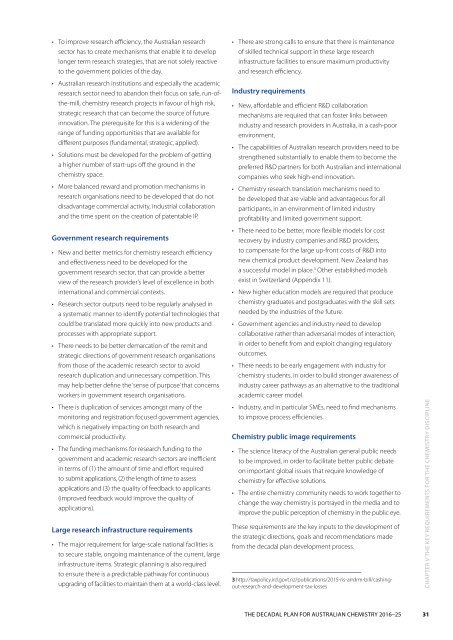Chemistry for a better life
1OiFLmD
1OiFLmD
You also want an ePaper? Increase the reach of your titles
YUMPU automatically turns print PDFs into web optimized ePapers that Google loves.
• To improve research efficiency, the Australian research<br />
sector has to create mechanisms that enable it to develop<br />
longer term research strategies, that are not solely reactive<br />
to the government policies of the day.<br />
• Australian research institutions and especially the academic<br />
research sector need to abandon their focus on safe, run-ofthe-mill,<br />
chemistry research projects in favour of high risk,<br />
strategic research that can become the source of future<br />
innovation. The prerequisite <strong>for</strong> this is a widening of the<br />
range of funding opportunities that are available <strong>for</strong><br />
different purposes (fundamental, strategic, applied).<br />
• Solutions must be developed <strong>for</strong> the problem of getting<br />
a higher number of start-ups off the ground in the<br />
chemistry space.<br />
• More balanced reward and promotion mechanisms in<br />
research organisations need to be developed that do not<br />
disadvantage commercial activity, industrial collaboration<br />
and the time spent on the creation of patentable IP.<br />
Government research requirements<br />
• New and <strong>better</strong> metrics <strong>for</strong> chemistry research efficiency<br />
and effectiveness need to be developed <strong>for</strong> the<br />
government research sector, that can provide a <strong>better</strong><br />
view of the research provider’s level of excellence in both<br />
international and commercial contexts.<br />
• Research sector outputs need to be regularly analysed in<br />
a systematic manner to identify potential technologies that<br />
could be translated more quickly into new products and<br />
processes with appropriate support.<br />
• There needs to be <strong>better</strong> demarcation of the remit and<br />
strategic directions of government research organisations<br />
from those of the academic research sector to avoid<br />
research duplication and unnecessary competition. This<br />
may help <strong>better</strong> define the ‘sense of purpose’ that concerns<br />
workers in government research organisations.<br />
• There is duplication of services amongst many of the<br />
monitoring and registration focused government agencies,<br />
which is negatively impacting on both research and<br />
commercial productivity.<br />
• The funding mechanisms <strong>for</strong> research funding to the<br />
government and academic research sectors are inefficient<br />
in terms of (1) the amount of time and ef<strong>for</strong>t required<br />
to submit applications, (2) the length of time to assess<br />
applications and (3) the quality of feedback to applicants<br />
(improved feedback would improve the quality of<br />
applications).<br />
Large research infrastructure requirements<br />
• The major requirement <strong>for</strong> large-scale national facilities is<br />
to secure stable, ongoing maintenance of the current, large<br />
infrastructure items. Strategic planning is also required<br />
to ensure there is a predictable pathway <strong>for</strong> continuous<br />
upgrading of facilities to maintain them at a world-class level.<br />
• There are strong calls to ensure that there is maintenance<br />
of skilled technical support in these large research<br />
infrastructure facilities to ensure maximum productivity<br />
and research efficiency.<br />
Industry requirements<br />
• New, af<strong>for</strong>dable and efficient R&D collaboration<br />
mechanisms are required that can foster links between<br />
industry and research providers in Australia, in a cash-poor<br />
environment.<br />
• The capabilities of Australian research providers need to be<br />
strengthened substantially to enable them to become the<br />
preferred R&D partners <strong>for</strong> both Australian and international<br />
companies who seek high-end innovation.<br />
• <strong>Chemistry</strong> research translation mechanisms need to<br />
be developed that are viable and advantageous <strong>for</strong> all<br />
participants, in an environment of limited industry<br />
profitability and limited government support.<br />
• There need to be <strong>better</strong>, more flexible models <strong>for</strong> cost<br />
recovery by industry companies and R&D providers,<br />
to compensate <strong>for</strong> the large up-front costs of R&D into<br />
new chemical product development. New Zealand has<br />
a successful model in place. 3 Other established models<br />
exist in Switzerland (Appendix 11).<br />
• New higher education models are required that produce<br />
chemistry graduates and postgraduates with the skill sets<br />
needed by the industries of the future.<br />
• Government agencies and industry need to develop<br />
collaborative rather than adversarial modes of interaction,<br />
in order to benefit from and exploit changing regulatory<br />
outcomes.<br />
• There needs to be early engagement with industry <strong>for</strong><br />
chemistry students, in order to build stronger awareness of<br />
industry career pathways as an alternative to the traditional<br />
academic career model.<br />
• Industry, and in particular SMEs, need to find mechanisms<br />
to improve process efficiencies.<br />
<strong>Chemistry</strong> public image requirements<br />
• The science literacy of the Australian general public needs<br />
to be improved, in order to facilitate <strong>better</strong> public debate<br />
on important global issues that require knowledge of<br />
chemistry <strong>for</strong> effective solutions.<br />
• The entire chemistry community needs to work together to<br />
change the way chemistry is portrayed in the media and to<br />
improve the public perception of chemistry in the public eye.<br />
These requirements are the key inputs to the development of<br />
the strategic directions, goals and recommendations made<br />
from the decadal plan development process.<br />
3 http://taxpolicy.ird.govt.nz/publications/2015-ris-arrdrm-bill/cashingout-research-and-development-tax-losses<br />
Chapter V The key requirements <strong>for</strong> the chemistry discipline<br />
THE DECADAL PLAN FOR AUSTRALIAN CHEMISTRY 2016–25 31


